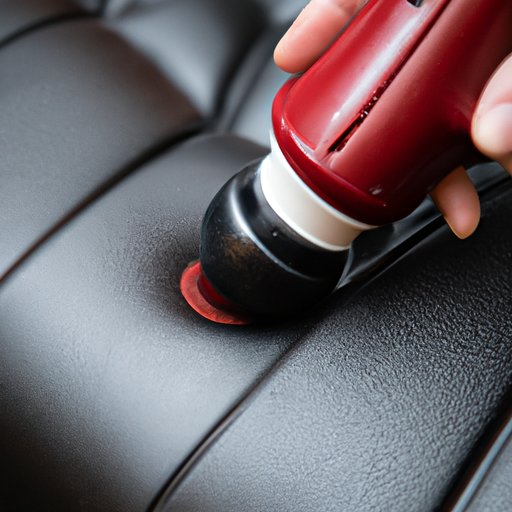
I. Introduction
Have you ever struggled with cleaning your leather car seats? Leather seats can be a luxurious and stylish feature in your vehicle. However, they require a bit more maintenance than fabric seats, and neglecting them can lead to damage and discoloration. In this article, we will provide you with a complete guide on how to clean leather car seats.
It’s crucial to maintain clean leather car seats to avoid discoloration, cracking, and eventual deterioration of the leather. In addition, regular cleaning will help keep the leather soft and supple, maintaining its elegant appearance. This article will guide you through the necessary steps and provide tips and tricks to make your life easier.
II. 5 steps to clean and maintain your leather car seats
Follow these five essential steps to ensure that your leather car seats are well-maintained and dirt-free:
A. Step 1: Vacuum the seats
Before cleaning your leather car seats, vacuum them thoroughly to remove any dirt and debris. Use a soft brush attachment and gently go over all surfaces of the seats. Be sure to reach the cracks and crevices where dirt can accumulate.
B. Step 2: Choose the right cleaner
Choose a specialized leather cleaner that will not harm the leather’s delicate surface. Be sure to test the cleaner on a small, inconspicuous area before applying it to the entire seat. Avoid using harsh chemicals, such as bleach or ammonia-based cleaners, which can cause discoloration and damage to your leather seats.
C. Step 3: Apply the cleaner
Apply the cleaner to a soft microfiber cloth, and gently rub it into the leather seat. Be careful not to over-saturate the leather with the cleaner. Work in small sections, and always follow the product’s instructions.
D. Step 4: Wipe off the cleaner
Use a clean soft cloth to wipe off the cleaner and any dirt or grime lifted from the leather seat. Be sure to remove all the cleaner residue to avoid leaving a sticky film that can attract dirt and bacteria.
E. Step 5: Condition the seats
After cleaning, condition your leather car seats to prevent discoloration, drying, and cracking over time. Choose a leather conditioner that is formulated for car seats, and apply it using a soft microfiber cloth. Work in small sections, and allow the conditioner to penetrate the leather for the time specified in the product’s instructions. Lastly, buff off any excess conditioner with a dry cloth.
III. The ultimate guide to remove stains from leather car seats
Stains on your leather seats can be frustrating, but don’t panic; they can usually be removed with the proper technique. Here’s what you need to know:
A. Identifying different types of stains
Identifying the stain type is essential to determine the correct cleaning method and product. Here are some of the most common stains and how to identify them:
- Food and drink stains: grease, coffee, soda, and wine can leave stubborn stains on your leather seats.
- Ink stains: ink from pens and markers can easily penetrate the leather and cause permanent damage if not removed promptly.
- Blood and bodily fluid stains: these stains can be unpleasant, but they can be removed with proper cleaning and disinfection.
- Mold and mildew stains: these stains are usually caused by moisture and high humidity levels. They can be difficult to remove, but it’s essential to address them promptly to prevent further damage and potential health hazards.
B. Recommendations for removing specific stains
Here are some recommendations for removing specific stains:
- Food and drink stains: Use a mixture of warm water and mild soap to clean the stain. Blot the stain with a clean, damp cloth, and repeat the process until the stain disappears.
- Ink stains: Use rubbing alcohol or non-acetone nail polish remover on a soft cloth to dab the stain gently.
- Blood and bodily fluid stains: Use a mixture of hydrogen peroxide and warm water in equal parts, and apply with a soft cloth. Repeat the process until the stain disappears.
- Mold and mildew stains: Use a mixture of one part white vinegar and one part water on a soft cloth, and dab the stained area. Leave it on for 10 to 15 minutes, then rinse with warm water and wipe dry with a clean cloth.
C. How to prevent future stains
Prevention is key to keeping your leather car seats looking like new. Here are some tips to avoid future stains:
- Keep food and drinks in closed containers to avoid spills and stains.
- Avoid smoking in your car, as tobacco stains are challenging to remove and cause odor retention.
- Use seat covers or towels to protect your seats, especially when transporting pets.
- Apply a leather protectant to create a barrier against staining agents and UV rays, which can cause fading and cracking over time.
IV. Troubleshooting: How to clean leather car seats and conquer difficult stains
Even with regular cleaning and maintenance, sometimes your leather seats may need extra attention. Here are some tips to address difficult stains and avoid common mistakes:
A. Tips for addressing stubborn stains
- Avoid scrubbing the stain harshly, as this can cause discoloration and damage to the leather surface.
- Use a specialized leather cleaner that is formulated to tackle tough stains, such as ink or grease.
- Consult with a professional cleaner if necessary, especially for severe or old stains.
B. Common mistakes to avoid
- Avoid using bleach or ammonia-based cleaners, as they can cause discoloration and damage to the leather.
- Avoid using abrasive tools, such as steel wool or abrasive sponges, which can leave scratches and damage the leather.
- Don’t over-saturate the leather with water or cleaner, as this can cause damage and discoloration.
C. How to avoid damaging the leather seats
To avoid damaging your leather seats:
- Avoid exposing your leather seats to direct sunlight for extended periods, as this can cause fading and cracking.
- Use a leather conditioner regularly to keep the seats soft and supple.
- Don’t apply cleaning products directly to the leather; always apply them to a soft cloth first.
V. DIY cleaning solutions for leather car seats using household items
Using household items can be a cost-effective and eco-friendly way to clean your leather car seats. Here are some DIY cleaning solutions:
A. Advantages of homemade solutions
- Homemade solutions are often less expensive than commercial cleaners.
- They can be made with natural and eco-friendly ingredients, reducing exposure to harsh chemicals.
- DIY solutions can be tailored to specific cleaning needs, and their effectiveness can be tested beforehand.
B. Detailed instructions for creating and using each solution
- Vinegar and olive oil: Mix one cup of white vinegar and half a cup of olive oil in a spray bottle. Shake the mixture well, and apply it to a soft cloth. Rub it gently onto the leather, and finish by buffing with a dry cloth.
- Baking soda and water: Mix equal parts baking soda and warm water to create a paste. Apply the paste to a soft cloth and rub it onto the leather in a circular motion. Wipe off with a damp cloth, and finish by buffing with a dry cloth.
- Lemon juice and cream of tartar: Mix equal parts lemon juice and cream of tartar to create a paste. Apply the paste to the stain and let it sit for 30 minutes. Wipe off with a damp cloth, and finish by buffing with a dry cloth.
C. Precautions to ensure effectiveness and avoid damage
When using homemade solutions, be sure to test them on a small, inconspicuous area first to avoid damage or discoloration. Always follow the instructions carefully and avoid using abrasive tools, which can scratch the leather.

VI. Preventative maintenance: Tips to keep your leather car seats looking like new
Preventative maintenance is essential to keep your leather car seats looking new for years to come. Here are some tips:
A. Regular cleaning routine
Create a regular cleaning routine, depending on how often you use your vehicle. This can prevent dirt and grime buildup and ensure that your car seats are always spotless and fresh.
B. Mindful use of the seats
Be mindful of what you bring into your vehicle and how you use your car seats. Avoid eating or drinking while sitting in your car, as spills and stains can quickly accumulate. Remember to take off your shoes and limit the use of sharp or pointed objects that can scratch or damage the leather.
C. Storage tips for long-term preservation
When storing your vehicle for long periods, take these steps to preserve the leather seats:
- Remove any debris and clean the seats thoroughly.
- Apply a leather conditioner to maintain the leather’s softness.
- Cover the seats with a protective blanket or cloth to prevent dust and sunlight exposure.
VII. Professional Leather Car Seat Cleaning: Is it Worth the Investment?
Professional leather car seat cleaning can be a great option in some circumstances. Here we’ll explore the advantages and other factors to consider before making a decision:
A. Advantages of professional cleaning
- Professional cleaners use specialized equipment and products that can remove tough stains and restore the leather’s appearance.
- They can provide deep cleaning and conditioning that can extend the life of your leather car seats.
- Professional cleaners can save time and effort, especially for large vehicles or severe stains, allowing you to focus on other things.
B. Cost comparison
The cost of professional cleaning can vary depending on the geographic location, the size of the vehicle, and the level of service needed. Expect to pay between $50 to $200 for a typical sedan, while larger vehicles and more extensive services may cost more.
C. Other factors to consider before making a decision
Before deciding on professional cleaning, consider the following:
- Check the professional’s credentials and experience, and ensure that they use safe and effective products.
- Research customer reviews and referrals to get an idea of their effectiveness and reliability.
- Determine if the cost outweighs the benefits based on your particular situation and budget.
VIII. Expert recommended products and techniques: How to clean and protect your leather car seats
Here are some expert recommended products and techniques to keep your leather car seats looking their best:
A. Recommended products
- Leather cleaner: Lexol leather cleaner is a highly-rated product that effectively removes dirt and maintains the leather’s appearance.
- Leather conditioner: Chemical Guys Leather Conditioner is a top-rated conditioner that nourishes and protects the leather, preventing discoloration and cracking.
- Leather protectant: Leather Honey Leather Conditioner is a versatile product that establishes a barrier against damage and UV rays, maintaining the leather’s elegance and longevity.
B. Step-by-step instructions for effective seat cleaning
For effective seat cleaning:
- Apply the cleaner to a soft microfiber cloth, and gently rub it into the leather seat.
- Work in small sections, and always follow the product’s instructions.
- Use a clean soft cloth to wipe off the cleaner and any dirt or grime lifted from the leather seat.
- Apply a leather conditioner to prevent drying and cracking over time.




